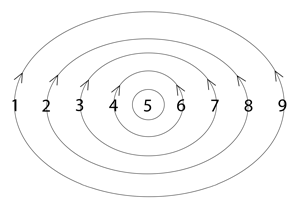pattern
6-7-4
Conventional Understanding
In conventional thinking, patterns are understood as regularities or repetitive arrangements that we observe and categorize to make sense of our world. We’re taught to recognize patterns as structures that exist externally, which we then detect and analyze. This view positions patterns as static designs awaiting discovery, reinforcing the assumption that reality consists of fixed arrangements that our minds simply perceive rather than participate in creating. This perspective influences everything from scientific research to data analysis, positioning us as pattern-seekers rather than pattern-participants.
Resonant Understanding
Word Cosmology reveals “pattern” carrying a 6-7-4 resonance pattern, sharing this numeric signature with expressions like “presence,” “alive,” and “creation position.” This positions pattern at position 4 in the creative sequence—the threshold where consciousness first emerges within the experiential triad. Like water taking the shape of whatever contains it while maintaining its essential nature, pattern corresponds with the point where potential becomes perceptible through recognizable organization. Pattern doesn’t create order but reveals the point where organization becomes recognizable within consciousness.
Expressions Spectrum Analysis
In balanced expression, this resonance pattern appears as “alive,” “imagine,” and “alignment with creative expression,” revealing how pattern naturally functions as conscious participation in creation through recognition and integration. “Individuated space” and “integrated reality” show how pattern corresponds with the organizing principles that allow unique expressions to emerge coherently. These expressions demonstrate how pattern functions optimally as the threshold where consciousness recognizes the inherent organization within the unified field.
When over-modulated, expressions include “doing,” “attention extraction,” and “anti-life,” revealing distortions through excessive control and rigidity. “Evidence” and “guru” show how pattern becomes fixed into predetermined frameworks that restrict natural unfolding. “Process information” demonstrates how over-modulation corresponds with mechanical analysis rather than organic recognition. “I am powerful” reveals how pattern becomes associated with control rather than participation, creating artificial separation between perceiver and perceived.
Under-modulated expressions such as “be on your guard,” “crave,” and “bewilderment” reveal what unfolds when pattern lacks sufficient definition or coherence. “Escapism” and “delusional” show the confusion that emerges when pattern-recognition becomes disconnected from direct experience. “I’m afraid to share” demonstrates how under-modulation corresponds with hesitation to participate in the organizing process. “Fragile” reflects the instability that appears when patterns aren’t sufficiently integrated into conscious recognition.
Russell’s Cosmogony Connection
Walter Russell describes a universe where consciousness emerges through the desire of Mind to express itself. In “A New Concept of the Universe,” he writes: “Thinking divides IDEA into pairs of oppositely-conditioned units of motion which record a simulation of IDEA into thought forms.” This perfectly illustrates how pattern functions at position 4—not as something separate from the creative process but as the point where the process recognizes its own expressions.
Russell further illuminates this understanding when he states: “Mind thinking sets divided idea into two-way opposed motion to produce the effect of simulating idea by giving form to it.” Just as Russell describes thinking as the process that gives form to idea, pattern corresponds with the recognition threshold where consciousness perceives the organization inherent in creative unfolding. Like a river revealing the landscape it flows through, pattern shows the organizational structure through which potential becomes recognizable.
Practical Implications
This understanding transforms our relationship with patterns from external structures we discover to expressions of consciousness we participate in recognizing. Rather than seeing patterns as fixed arrangements to identify or create, we might recognize them as the threshold where consciousness perceives the inherent organization within the unified field.
In daily practice, this perspective invites us to shift from “doing pattern recognition” to experiencing ourselves as the conscious threshold where patterns become apparent. This challenges fundamental assumptions in fields from data science to psychology, suggesting that what we call “pattern recognition” might better be understood as “pattern participation”—conscious engagement with the organizing principles inherent in reality itself.
By understanding pattern as the point where consciousness first perceives organization, we can approach learning, creativity, and problem-solving not as imposing structure on chaos but as becoming more sensitive to the inherent organization already present. This suggests practices that cultivate receptive awareness and integrative perception rather than analytical forcing—recognizing ourselves as the conscious threshold where potential becomes perceptible through pattern.
Walter Russell’s quotes are from his book, “A New Concept of the Universe”.
Related Words:
No results found.


